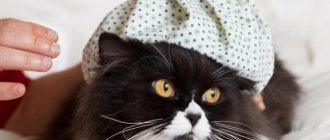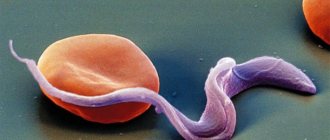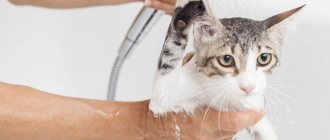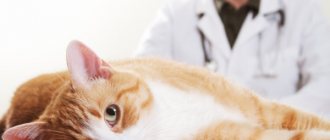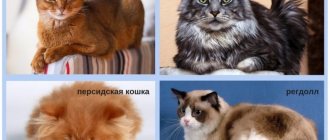Predisposition of cats to hyperthyroidism Symptoms Causes of hyperthyroidism in cats Diagnosis Treatment Prognosis Prevention Hyperthyroidism in cats is a disorder that is characterized by increased synthesis of thyroid hormones and subsequent acceleration of metabolism. The thyroid gland is located in the neck and plays a large role in regulating metabolism in the body. This is a fairly common disease in adult cats. Despite the enlargement of the thyroid gland, this disease is usually benign. A thyroid tumor occurs in less than 2% of cases of feline hyperthyroidism.
This disease affects many organs, including the heart. The heartbeat becomes faster and stronger, which ultimately leads to an enlarged heart. An increased heart rate leads to increased blood output and increased blood pressure. More than 25% of cats with hyperthyroidism have high blood pressure.
Symptoms of hyperthyroidism in cats
The typical cat with hyperthyroidism is a middle-aged or older cat; on average, cats over 12 years of age are affected. Most of them experience weight loss due to increased metabolism. The cat's body tries to compensate for the lack of weight by increasing its appetite. Outwardly, the cat seems constantly hungry and is ready to eat literally everything it sees. Despite their increased appetite, many cats continue to lose weight. Weight loss can occur gradually, without owners realizing it, or it can be rapid. Sick cats drink water often and in small portions, and urination also becomes more frequent. Periodic vomiting or diarrhea may occur, and hair loss may occur. Some cats develop anorexia.
Two secondary complications of this disease are important. These include hypertension (increased blood pressure) and a heart condition called thyrotoxic cardiomyopathy. Hypertension occurs due to increased cardiac output. In some cats, increased blood pressure leads to hemorrhages and retinal detachment, and, as a result, blindness. Heart problems arise due to its expansion and thickening of its wall. Both of these changes are reversible with adequate treatment.
Symptoms
Thyroid hormones, produced in large quantities, can have a negative effect on almost all organs of the animal. However, in some cats hyperthyroidism manifests itself with one or two signs, while in others the disease has a multifaceted symptomatic picture.
Fistula
Urethrostomy
Sinusitis
The pathology in question develops gradually, which can mislead the animal owner: many people mistakenly associate weight loss and dull fur with the natural aging of their pet, and are in no hurry to show it to the veterinarian.
Since the disease most often affects animals over 8 years of age, it is important to carefully monitor the health of older cats. You can tell that your pet has problems with the thyroid gland by the following signs:
- Weight loss and sometimes extreme exhaustion.
- Thirst, excessive appetite.
- Increased number of urinations.
- Periodic occurrence of vomiting and diarrhea.
- Rapid heartbeat, shortness of breath.
- Lethargy, irritability.
Half of the patients experience skin damage, manifested in the form of:
- Oily seborrhea.
- Spontaneous hair loss.
- Hair matting (this symptom is more pronounced in long-haired animals).
- Baldness on the sides resulting from excessive licking.
- Acceleration of claw growth.
If you detect at least a few symptoms of hyperthyroidism in a cat, you should not attribute them to natural aging. A timely visit to the veterinarian will help start treatment on time and prevent the development of complications dangerous to the cat’s health.
Treatment of hyperthyroidism in cats
Because malignant degeneration of the thyroid gland is rare, treatment is usually successful. There are three treatment options, the choice of which one depends on the specific case. Many factors are taken into account when choosing treatment for a cat.
Three treatment options:
Oral medications.
Prescribing an oral medication (methimazole) helps control the effects of an overactive thyroid gland. Some cats have a reaction to the medication, but this occurs infrequently (less than 20%). However, side effects may appear even 6 months after the start of treatment, these include vomiting, lethargy, anorexia, fever, anemia (decreased number of red blood cells). Methimazole does not destroy the affected thyroid tissue; rather, it prevents the excessive synthesis of hormones. Therefore, medicine should be given to prolong the life of the cat. To regulate the dosage, it is necessary to periodically conduct blood tests. This treatment is indicated for cats that cannot undergo surgery due to other health problems. Over a period of several weeks, this treatment can also be used to stabilize a cat that is at risk for surgery due to a cardiac complication.
Operative method.
Surgical removal of the affected lobes of the thyroid gland is very effective. Since hyperthyroidism usually affects cats over 8 years of age, there is a certain risk with this treatment. However, if the cat has no other illnesses, the risk is minimal. In most cats, only one lobe of the thyroid gland is affected. Cats requiring surgical treatment are brought to the clinic on the morning of the operation and discharged in the evening.
Radioactive iodine.
There is an additional treatment for hyperthyroidism using radioactive iodine (I131). It is given in injection form and destroys all abnormal thyroid tissue without damaging other organs. Treatment is carried out in a veterinary clinic that has permission to provide radiation therapy, and takes 1-2 weeks. Sometimes, but not always, the cost of this treatment exceeds the cost of other options. This therapy destroys all thyroid tissue, so you should consider all side effects and end results before starting treatment.
If surgery is chosen, the cat is often given oral medications several weeks before surgery. During this time, the appetite normalizes and the animal usually gains weight. Pre-treatment with medication also helps resolve the problem of increased heart rate and high blood pressure. After a few weeks, it is necessary to recheck the levels of kidney indicators and thyroid hormones in the blood.
Recurrence of the disease is possible in some cats, although this is rare after treatment with iodine. After surgery, this phenomenon is possible if abnormal thyroid cells still remain in the cat's body. These cells begin to divide, causing the disease to return. But this happens only in 5% of cases and usually 2-4 years after surgery. Another possibility is that lobes of the thyroid gland that appeared normal were not removed during surgery. Subsequently, months or years later, they become abnormal.
Description of the disease
The cat's thyroid gland has two lobes, located to the right and left of the trachea. Their function is to produce the hormones thyroxine T4 and triiodothyronine T3. Thyroid dysfunction leads to an increase in the size of one or both lobes, which begin to produce excessive amounts of hormones.
T3 and T4 hormones are necessary for normal cell growth and development. They participate in the metabolic processes of proteins, carbohydrates and fats, normalize heat exchange, and improve oxygen supply to tissues.
As their number increases, metabolic processes begin to occur at a much higher speed, which creates a high load on the body. This leads to the development of problems with blood pressure, liver, kidneys, gastrointestinal tract, musculoskeletal system, and heart. Patients with hyperthyroidism often suffer from cardiovascular pathologies.
As observations show, the disease is least common in cats of the Himalayan and Siamese breeds.
General description of the disease
Hyperthyroidism in dogs is quite rare. Research shows that most often only one in 150-500 healthy individuals is sick, depending on the breed and the presence of other unfavorable factors. Large and medium-sized dogs are more susceptible to hyperthyroidism. Small breeds have a low risk of developing this disease. Gender is not associated with the occurrence of hyperthyroidism among dogs.
Hyperthyroidism also occurs in cats. It affects animals as young as 8 years old. Most of all it is diagnosed in individuals 12-13 years old. The disease affects both sexes equally. Also, its course is not affected by the breed of the cat.
What are the violations associated with: the main reasons
According to the candidate of veterinary sciences, Ignatenko N.A., unlike people, in cats and kittens, increased production of thyroid hormones occurs against the background of autonomous hyperfunction of the internal organ, while the disorder affects one lobe or both at once (https://vetpharma.org /articles/97/2355/).
There are many reasons for thyroiditis in cats and other endocrine system disorders. It is equally important what the pet eats and how often it eats, since an unbalanced diet is one of the main sources of progression of thyroid disease in pets. With pathologies, iodine ceases to be absorbed normally, which leads to various disorders. There are such factors against the background of which thyroid hormones in cats increase or decrease:
The endocrine organ stops working normally when the animal is constantly under stress.
- frequent stress;
- increased excitability;
- excessive physical or mental stress;
- various chronic diseases;
- exposure to radiation on a pet;
- treating the cat with hormonal drugs or steroids.
How is diagnosis carried out?
The prognosis for thyroid disease depends on how promptly the cat’s owners go to the veterinary clinic. In case of illness, a specialist first examines the pet and determines its condition. To make a final diagnosis, the pet's anatomy and blood pressure measurements are equally important. The following laboratory and instrumental examinations are used for diagnosis:
During the examination of the animal, the endocrine organ is palpated.
- palpation of the thyroid gland;
- blood analysis;
- tomography of the internal organ;
- measuring TSH in cats.
Varieties and clinical signs
How to recognize hyperthyroidism?
In veterinary medicine, a similar phenomenon is also known as hyperthyroidism or thyrotoxicosis, which is characterized by increased production of thyroid hormones. In most cases, an overestimated rate is recorded in cats that are more than 6 years old, but a failure can also occur in a young individual, including a kitten. The progression of pathology is influenced by various internal and external factors, but sometimes veterinarians fail to determine the mechanisms of development of thyrotoxicosis in cats. When a pet's thyroid gland is overworked, the following symptoms occur:
Increased work of the organ is expressed by increased activity of the animal.
- a constant desire to eat, while a decrease in body weight is recorded;
- increased thirst that is difficult to quench;
- increased excretion of urine;
- nausea, which may cause vomiting;
- diarrhea;
- hyperactivity;
- increased excitability;
- irritability;
- impaired breathing, which is associated with abnormalities of the cardiovascular system;
- shortness of breath and noises when inhaling and exhaling.
A cat with hyperthyroidism changes in appearance, its fur becomes greasy and dirty, and hair loss is often noted.
Symptoms of hypothyroidism
Hyperfunction can be replaced by hypo-function, as a result of which the thyroid gland produces insufficient hormones, and the pet’s body is not able to function normally. With pathology in the cat's body, insufficient production of thyroxine occurs, which can lead to the following pathological signs in the cat:
A decrease in organ function leads to excess weight gain in animals.
- apathetic state;
- lethargy and lack of mobility;
- deterioration in the appearance of fur, which provokes its loss;
- the appearance of alopecia at the site of baldness;
- low body temperature;
- slow metabolism in the pet’s body;
- decreased number of heart contractions;
- problems with excess weight;
- constant constipation.
If a disease of the thyroid gland appears in a young individual, then slow growth may be observed. Hypothyroidism in pregnant cats causes them to give birth to dwarf kittens, which take a long time to develop mentally and physically. In this case, it is necessary to show the small animal to the veterinarian as soon as possible in order to avoid serious complications.
Laboratory diagnostic methods
If a thyroid dysfunction is suspected, a comprehensive examination of the cat is required. Diagnostics includes the following activities:
- Anamnesis collection, visual examination of the cat, assessment of its fatness and coat condition.
- Carrying out instrumental examination methods.
- Laboratory research.
The doctor measures the pet’s blood pressure and temperature, listens to the heartbeat, palpates the abdominal organs, and studies the condition and size of the thyroid gland.
You cannot palpate the animal’s thyroid gland yourself. Careless movements can provoke the release of a large amount of hormones into the blood and the sudden development of a thyrotoxic crisis. To improve visualization, it is recommended to cut the hair on the cat's neck short.
A study of biochemical and general blood tests in patients shows an increase in the level of the hormone T4 or the presence of macrocytosis, which indicates the negative effect of thyroid hormones on hematopoiesis.
The presence of hyperthyroidism is indicated by high levels of alkaline phosphatase, transaminases, and renal parameters (creatinine and urea).
Normal levels of the T4 hormone for cats are from 15 to 50 nmol/l. A significant excess of this norm indicates the presence of hyperthyroidism in the animal being examined.
If necessary, the veterinarian prescribes an echocardiogram of the heart, an x-ray, and an ultrasound of the thyroid gland and abdominal cavity to the patient.
Causes of the disease
As we said, hypothyroidism in cats is rare, and therefore its causes are not well understood. But there are still interesting assumptions on this matter. So, an outbreak of this pathology occurred in 1979, and those animals that lived along the shores of the Tokyo Strait were sick. Interestingly, this happened around the time that whales and herring gulls in the St. Lawrence Seaway and great cormorants in Tokyo Bay were dying en masse from thyroid problems. It subsequently turned out that the water in those areas was heavily polluted with certain chemicals.
More precisely, they were polybrominated diphenyl ethers (PBDEs). They have polluted the environment extensively since the 1970s. Their concentration is very high in the liver of some fish, and therefore cats are simply poisoned by eating “healthy” seafood.
Prevention of hyperthyroidism
Veterinary diet Hills Prescription Diet Feline Y/D Thyroid Health (Hills Prescription Diet Feline Why/D Thyroid Health) is a diet with limited iodine content.
Thanks to its special composition, it restores the functioning of the thyroid gland, supports the functioning of the kidneys, bladder, heart, and improves the quality of the coat. Gag Hyperthyroidism in cats is not exotic at all. This is a fairly common endocrine disease in older cats. The trouble is that it is poorly diagnosed - not every doctor will suspect hyperthyroidism, and not every clinic has tests for the content of thyroxine in the blood serum. And often, when dealing with the symptom of “weight loss with excellent appetite,” you can get advice to deworm your pet. No, deworming is certainly necessary, but there is also hyperthyroidism. It's good that now we know about him!
( 17 ratings, average: 4.88 out of 5)
Treatment
To eliminate the symptoms of hyperthyroidism in a cat and prevent complications that this disease causes, both conservative and surgical methods of therapy are used. Due to the lack of effective, safe medications in our country, treatment is most often carried out by surgical excision of one or both lobes of the thyroid gland. This approach is simple and low cost.
Surgery is also necessary if the animal has a malignant or benign tumor. The cost of the operation is high, but if it is performed successfully, the pet will quickly recover.
First aid
Drug treatment is aimed at suppressing excess hormone synthesis. The following drugs are used:
- Metamazole.
- Carbimazole.
- Thiamazole.
The disadvantage of drug therapy using the listed drugs is their ability to cause numerous adverse reactions on the animal body. About 20% of cats suffer from nausea, vomiting, decreased appetite, and itching after using the tablets. Medicines can also change the condition and formula of the blood. Therefore, their use is justified in the first days of treatment, when the cat needs an emergency reduction in hormone levels.
It is possible to achieve complete disappearance of the symptoms of hyperthyroidism with the help of oral medications in just 2 weeks of treatment. Provided that cats are well tolerated, these tablets are prescribed for life.
Basic treatment
As a primary treatment, veterinarians recommend feeding pets a special complete food designed for cats with hyperthyroidism. Such foods are prescribed after normalizing hormone levels using tablets. They contain a minimal amount of iodine, which stimulates the production of hormones. Iodine deficiency in an animal’s body helps to reduce the level of T3 and T4 naturally.
It is necessary to switch to therapeutic nutrition gradually, over 1-3 weeks. When the cat completely switches to the new food, after 3 weeks the level of thyroxine in the blood is measured. As a rule, its content decreases noticeably, which allows the patient’s condition to normalize. You should not give him treats from the table or other additional food.
Diagnosis of the disease
Hyperthyroidism in cats and dogs manifests itself in the same way as chronic renal failure, liver disease or neoplasia. These pathological conditions must be excluded during diagnosis of the animal's condition. Examination of a cat or dog should include:
- carrying out general analysis and blood biochemistry;
- determination of thyroid hormone levels (total T4);
- urine test.
In some cases, chest X-ray, ECG, and coprogram are indicated.
When receiving the result from a general blood test, there is no change in the number of red blood cells or hematocrit. A fifth of animals exhibit macrocytosis. A significant concentration of thyroid hormones promotes the release of a significant amount of erythropoietin, which, in turn, increases macroerythrocytes. You can also identify a condition that is characterized as a stress leukogram.
Analyzing the biochemical blood test, the high activity of liver enzymes and alkaline phosphatase is striking. However, these changes are characterized as minor
If deviations from the norm are significant, concomitant diseases must be taken into account. When examining electrolytes, in most cases no negative changes are observed
Hyperthyroidism is also often accompanied by an increase in the concentration of urea and creatinine.
In most cases, to make an accurate diagnosis, it is enough just to determine the level of thyroxine in the animal’s blood. The presence of the disease is indicated by an increase in the concentration of this hormone. If, after the analysis, indicators are identified that are at the upper limit of normal, it is necessary to repeat the study after 2-6 weeks. This result may indicate the presence of concomitant pathologies.
Heart rate and rhythm in cats with hyperthyroidism
Tachycardia is often just a manifestation of stress experienced by the animal, however, in all cases of arrhythmias, a comprehensive and thorough examination of patients is necessary. Extrasystoles are typically quieter than normal heart sounds, and clinicians are usually more concerned about the duration of pauses after such heartbeats (Paige CF, Abbott JA, Elvinger F, et al. Prevalence of cardiomyopathy in apparently healthy cats. J Am Vet Med Assoc 2009). Simultaneous palpation of the pulse in the femoral artery may be useful. With tachyarrhythmias, pulse deficiency is manifested by audible sounds of heart contractions in the absence of a corresponding pulse wave.
Prevention
Prevention of hyperthyroidism in cats involves limiting the intake of iodine in the body. Therefore, you should not overuse fish dishes, seafood, or canned food. To minimize the risk of developing hyperthyroidism, it is recommended to visit your veterinarian annually. In addition, the pet's blood is regularly tested for hormone levels.
In advanced stages of the disease, the prognosis is generally unfavorable. Most animals manage to live no more than 2-5 years from the moment of diagnosis.
The use of special foods that contain a low amount of iodine can improve the quality of life of your pet. A special food designed for cats with hyperthyroidism helps reduce hormone levels. When there is iodine deficiency in a pet's body, there is a natural decrease in the levels of T3 and T4 hormones.
In the absence of proper treatment, the disease leads to increased stress on the body. As a result, the cat's internal organs work to the limit of their capabilities.
This leads to a deterioration in the cat's well-being. In some cases, kidney inflammation occurs, congestive heart failure and chronic diarrhea develop.
The situation can be saved by changing the diet and taking appropriate medications for life, or surgery.



